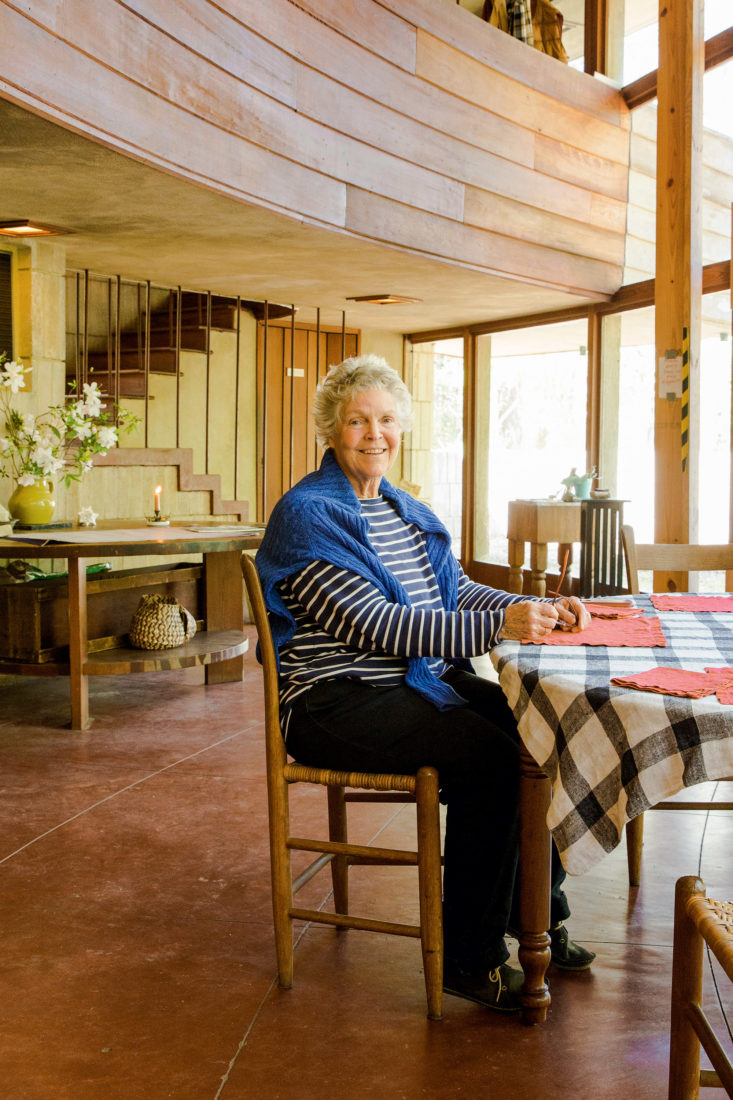Byrd Lewis Mashburn steps out of her tiny bedroom and leans against a sweeping balcony made of tidewater red cypress, a favorite building material of her home’s architect, one Frank Lloyd Wright. The septuagenarian points to the concrete floor, dyed in Wright’s iconic Cherokee Red, and to what lies beyond the living room’s towering windows. Where others see Wright’s only private residence built in Florida, Mashburn finds memories: the balcony where she slept beneath the stars with her brothers; the nook where they’d stand a huge pine at Christmas; and the home’s original, circular table, where her father, George Lewis, served fresh-caught redfish for supper.
To Mashburn, the nearly 2,300-square-foot Lewis Spring House, north of Tallahassee, is not only her home but a family member—an ailing one. Tarps protect the leaky circular core from which the rooms fan out. Lizards scurry across plywood that has supplanted a couple of doors. Added wooden columns reduce stress on the plate glass, and more plywood stabilizes the plaster ceiling. Still, the house remains structurally sound. “It’s impressive the way it all holds itself up,” says architect Kevin Schweizer, whose late father, Nils, was sent by Wright in the 1950s to oversee construction.
In 2014, the National Trust for Historic Preservation included Spring House on its list of America’s “11 Most Endangered Places.” The cost to buy out the family, rehab the property, and manage the nonprofit Spring House Institute is an estimated $1.5 million; otherwise, raising funds to maintain the home falls on Mashburn, the Institute, and grassroots cohorts—students, architects, friends, and Wright fanatics who’ve begun rallying behind the cause and, slowly, making a difference.

Photo: Gabriel Hanway
Byrd Lewis Mashburn sits in the light-filled interior.
Spring House’s condition links back to the politics of Mashburn’s parents. George’s family owned the oldest bank in Florida, of which he was eventually named president. He and his wife, Clifton, became Wright fans after seeing his work in magazines and books, and when the architect gave a speech at Florida Southern College in 1950, Clifton made a bold request: “Mr. Wright, we’re the Lewises, and we are from Tallahassee. We have a lot of children and not much money, and we hope you will do a house for us.” Wright took the job, challenging the couple to “find your ground.” A year later, the Lewises discovered five then-rural acres with a natural spring (thus the name). Using topographical maps and photos, Wright sketched the structure from afar, nodding to George’s love of watercraft with connected arcs and windows resembling portholes. In late 1954, the Lewis family moved in.
That same year, school segregation was ruled unconstitutional, and the Lewises became champions of civil rights—the stand cost George his position. “As time went on, it affected the family financially, because their actions were not popular,” says Steve Cooper, a family friend. Maintenance at Spring House was put off, and its condition declined. Cooper, a retired pilot and Institute board member, energized upkeep efforts last year by pledging to speak at national seminars and appeal to corporate, government, and preservation-focused entities. Meanwhile, although volunteers visit Spring House for a monthly cleanup, the fifteen-dollar public tours and capital campaign aren’t enough to save the home.
Mashburn dreams that a revived Spring House will host classes about Wright, architecture, and native plants, as well as weddings, poetry readings, and overnight guests. She is also open to selling to private buyers with the means to restore. Either way, she says, “we’re doing what my parents hoped would be done here.”








